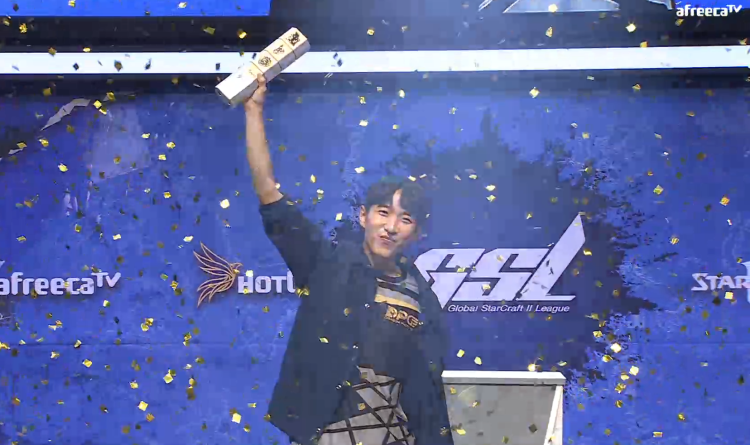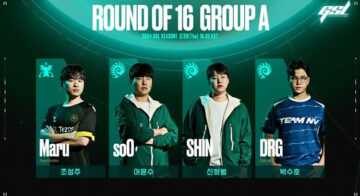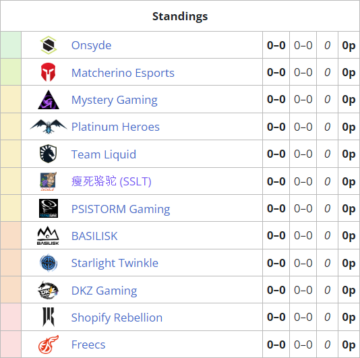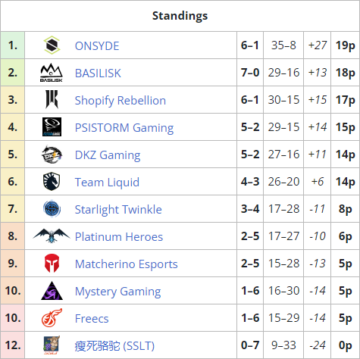by Mizenhauer
There is a list. It is one that has been compiled from almost the dawn of StarCraft II history, including some of the best players to ever—legends such as soO, sOs and Marineking. It is a quirky list, however, because it highlights both success and failure. The list I’m speaking of? The best Korean players to never win Code S.
That list is one item shorter now, because herO can no longer be included.
It truly has been a long time coming for one of Korea’s elite. herO trip to the finals was no flash in the pan, stumbling in after making the run of a lifetime. He was a hardened veteran with plenty of experience playing under pressure, and it showed. He approached the finals with confidence and his play was exacting. He seemed a step ahead of Maru at all times and left the four time champion chasing his own shadow as much as he pursued herO’s units. It was the complete performance you would expect from someone who had already won six major championships.
Though lacking a Code S title until last week, herO had already been the victor of a “Tier 1” Korean event in 2015, when he emerged victorious in the third season of the SSL (StarCraft II Starleague). That was the crowning achievement of herO’s first career peak, capping off a two year run from 2013 to 2015 where he won three IEM satellite events, finished second in the IEM World Championship, reached the RO4 of both Code S and SSL, and was the undisputed ace of CJ Entus in the Proleague.
His accolades elevated him to a place among the best Korean Protosses to that point—Rain, sOs, PartinG, Classic and Zest—each and every one of them was a contender to win any event they entered. But where Zest was renowned for his overall sense of strategy and sOs was celebrated for his devious builds, herO was defined by his micro. His ability to control blink stalkers, in particular, was unparalleled and proved indispensable on the road to lifting one after another.
If the list of great players to never win a Code S title has lost a member, then there’s another list that has added a name. This list is much more exclusive.
Many players have returned to StarCraft II after completing their military service, and some even won major tournaments like ByuN. But no one had returned and regained enough strength to win GSL Code S. Returnees flashed great promise, but most flamed out as quickly as they rose to prominence. Others plateaued and never recovered their abilities, existing in stasis as a husk of their former selves. Then herO came back and became the first on the list of returnee Code S champions.
In retrospect, herO left StarCraft II at a very opportune time. Despite a successful 2019 campaign in which herO reached the semifinals of three premier events, he packed up his mouse and keyboard and stepped away from the game he loved in December 2019. The next eighteen months of Code S were dominated by powerhouses like TY, Maru, Rogue and Dark at the peak of their abilities.
When herO first came back from his military service, he was found very wanting. But, that is the nature of returning to StarCraft II after such a long period of time. You have to redevelop the habits and movements to control your army as you once did. You need to play hundreds of games to get a sense for a greatly changed meta. herO did all that and more. Instead of adopting the modern style of PvT and PvZ, herO took it a step further and aspired to rewrite the book when it came to both matchups.
herO took his lumps for more than a year, continuing to improve his skills in the face of disappointing tournament finishes. Bit by bit he devised and refined a hyper aggressive play style reminiscent of the one that helped him win SSL in 2015. Armed with his trademarked unit—the Blink-Stalker—herO optimized a Gateway-oriented strategy focused on pressuring, containing and even killing the opponent while rapidly expanding back at home. Even as he failed to make an impact in individual tournaments, he became a tremendous player in online cups and a powerful force for Dragon Phoenix Gaming in WTL. His infamy on the ladder rose to such a level that many of his peers pointed to him as a future champion headed into the summer of 2022.
herO’s solution to PvT peaked last Friday as he dominated Maru in a manner rarely seen during the legendary Terran’s decade playing StarCraft II. The series may not have been a clean sweep, with Maru salvaging game three, but in the other four he was perpetually a step ahead. Game one was won due to a non-stop stream of attacks, starting with a proxy-Gateway and ending with a deluge of Zealot-Stalker. Games two and four were won with defense, with herO stoutly holding his ground against wave after wave of all-ins.
Game five was the real masterclass of the finals, with herO showing off the might of his style. Firmly in the driver’s seat on Cosmic Sapphire, herO pinned Maru in a tiny corner of the map. Every time Maru ventured forth, herO punished him for it. Every time Maru tried to establish a new expansion, herO meticulously attacked the seam that opened up on the other end of the map. Not only did Maru get the worse end of pitched battles, but he was also unable to replace his losses due to his pitiful economy.
Looking back at it now, Maru never had a shot. herO made sure of that by never allowing Maru to gain a footing in the match. This is not the type of title on which you can tack on an asterisk. herO faced off against the best Terran player of all time and took home the trophy with ease.
There is a third and final list to talk about. This one is frequently referenced, mostly during discussions on balance. This ledger is the one of Protoss Code S champions, and it’s astounding that it remained untouched for five years and four months up to now.
Though we celebrated the wins of Dark, Rogue, Maru, and their Terran and Zerg brothers, there was an aura of unease to it all. Were things ever going to change? Was this truly the fate of Code S for all time? But on Friday night, herO finally ended the drought. We watched in awe as herO became the first Protoss in over a half decade to win Code S. We sat, mouths agape, as a player who should have long past his prime announced himself as the best player in the world. We saw a man who defied the odds. Who refused to accept what appeared to be the inevitable fate of those who return to StarCraft II with their service complete.
Last week, herO added himself to two lists and removed himself from another. He etched his place in history and won the tournament which had always escaped him. In doing so, he set a new standard. Not just for Protoss. Not just for military returnees. He showed that the series of our life is within us somewhere—a moment where we overcome the obstacles and become something greater. It took herO 13 years as a StarCraft pro to find this moment. This perfect match that tore conventions to shreds, forced us to reevaluate all three races and culminated with herO celebrating on stage. It took some time, but he Smiling Assassin, back where he belongs. Trophy in hand, confetti in the air, and his signature grin on his face for all to see.
[embedded content]
Match Recaps
by Wax
Game 1 – Blackburn (herO win): herO rolled out with an aggressive build in game one, going for a slightly proxied Gateway at the deceleration zone just outside of his main base. Maru, despite not seeing a Gateway in a normal position with his scouting SCV, still proceeded to go for a Reactor expansion directly on the low ground.
This ended up costing Maru dearly against herO’s stream of units from a single Gateway, later joined by Oracles from a Stargate. As Maru was suffering considerable SCV and Marines to this harassment, herO was able to safely expand to both Maru’s gold base and his own gold base. herO kept up the pressure with Blink-Stalkers, after which he looked to transition into a mass-Gateway unit style powered by the double gold bases.
Maru had been so damaged by early game harassment that he couldn’t challenge the audacious Protoss expansion on his side of the map. He was quickly overrun by an overwhelming army of Zealots and Stalkers and forced to GG out.
Game 2 – Curious Minds (herO win): Perhaps influenced by game one, Maru decided to play a more conservative Reaper-Factory expansion opener in game two. herO followed suit, going for a defensive Blink Stalker strategy.
After establishing three bases, herO decided to rush up to Psionic Storm. He even went for an ambitious two-Storm drop, which barely did any damage thanks to Maru’s quick reaction. Whether it was his original plan or because he saw two wasted Storms, Maru decided to delay his third base and go for a two-base all-in at around the 7:30 mark. While the massive attack with bio, Tanks, and a throng of SCVs was meant to decide the game, it actually ended up being quite inconclusive. Maru was able to destroy herO’s natural and dozens of Probes, but herO was ultimately able to force Maru to retreat.
Rather than take a third base, Maru decided to stay on two bases and mass troops for a second attack—this time with Ghosts in tow. That second attack seemed like it might push herO over the edge as he didn’t have the breathing room to add any Disruptors to counter the Ghosts. However, his Prism-Templar micro was good enough to let him land some very juicy Storms, allowing him to repel Maru again.
Maru finally took a third base at the 12-minute mark, but he was still looking to stay aggressive and break through herO’s defenses with another attack. However, the previous successful hold had given herO the space to finally add some Disruptors to his army, which ended up making a huge difference. herO was able to crush Maru’s third attack with relative ease, finally taking a decisive lead in the game
With game-ending attacks no longer an option, Maru was forced to enter a defensive stance and try to drag the game out. But herO proved to be methodical with his lead, resisting the temptation to over-expand while using his Disruptor advantage to take chunks out of Maru’s army and economy. Eventually, Maru was forced into a desperation fight to try and hold onto a key base, and surrendered after his army was thoroughly purified.
Game 3 – Hardwire (Maru win): Maru started with a Reaper-Factory expansion again, getting out a fast Cyclone which nullified herO’s hidden Stargate Oracle opener. He even managed to sneak a two-Mine drop into the Protoss main which almost did game-ending damage due to slow reactions, but herO responded just in time to limit his loss to 6 Probes.
Still, this gave Maru his best start of the series, and he was able to comfortably take a third base while applying heavy pressure with his bio in the mid-game. Maru stayed aggressive after establishing his 3-base economy, adding Ghosts to his army and roaming about on herO’s side of the map.
This aggressive stance almost backfired for Maru, as herO managed to stall him out with Templars and Disruptors while doing decent damage with Zealot backdoors. However, an instance of horrible mispositioning saw a big group of herO’s disruptors get picked off for free, swinging all the momentum back in Maru’s favor.
Perhaps due to the pressure of being forced into a map-split game on Maru’s terms, herO went deep into Terran territory for an attack on Maru’s fifth base. However, attacking into a position defended by a Planetary Fortress proved to be quite unwise, and herO made his situation worse by firing off his Purification Novas wastefully. This invited Maru to collapse upon herO’s army and smash it in a complete rout. From there, it was a simple clean-up job for Maru, who needed just a few minutes to collect the GG.
Game 4 – Berlingrad (herO win): Maru continued his trend of playing Factory expansions with a Cyclone, while herO changed things up with a 4-Gate Blink-Stalker strategy. He hit the jackpot with his first big forward Blink, killing off both Maru’s first Tank and Cyclone at the same time. This opened up Maru to continued Stalker harassment, which while not fatal, did allow herO take a third base and set himself up marvelously for the mid-game.
Pre-planned or not, Maru opted to pull the boys and go for another 2-base all-in at around the 7:30 mark. However, herO was already in a fantastic position with both Immortals and Archons to help him on defense, and he was able to easily ward off Maru’s attack.
Maru continued to play from an all-in position, adding Ghosts and going for another attack a few minutes later. However, he was still outgunned by the Protoss force, with the Ghosts offering no reprieve from Templars protected by a Warp Prism.
It’s a credit to Maru that his third, desperate attack was actually a success, trading decently against herO’s army. However, Maru was too far behind for it to make a difference, and he had to surrender once herO regrouped his forces.
Game 5 – Cosmic Sapphire (herO win): herO opened up with a defensive Blink build while Maru changed up his Factory opener to go for a fast 2-Mine drop. herO’s reaction speed was up to the task, however, and he nullified the drop without taking significant damage. Given the extremely large battlefield, the two players settled into a passive build up with neither player looking to be especially aggressive until the mid-game. Maru poked around with his Medivacs once he had stim, but there weren’t many meaningful openings to be found. Similarly, herO went for some Storm drops that picked off SCVs, but it didn’t affect the big picture as the two players progressed toward a half-map split.
The turning point in the game came once the two players were maxed out and established on 5+ bases. As the two main armies jockeyed for position, they ended up missing each other and initiating a semi-basetrade. While Maru’s forces were able to burn through a couple of herO’s frontier expansions, herO’s army had a vector straight into Maru’s main base. While Maru hastily retreated his forces after killing off the expansions, it was extremely tricky for him to engage a Protoss force that had set itself up on top of his own ramp. Maru was eventually able to force a tactical recall from herO, but he came out the loser on the balance sheet of damage taken.
Having seized the initiative, herO put his foot on the gas. With an army composed of primary Gateway units and Disruptors, herO set about attacking Maru’s two outermost expansions that were the furthest distance apart. Even the speedy Maru had trouble redeploying his Tanks constantly to cover each position, and he started to bleed away units, SCVs, and Orbital Commands. While herO couldn’t deal fatal damage to Maru in one blow, he managed to keep him pinned down in one corner of a map, putting him on a slow death timer where he would run out of resources if he couldn’t secure more bases.
Unfortunately for Maru, there was no escaping the slow, downward spiral. No matter what he did, he couldn’t break out of his corner of the map and take new expansions. herO continued to keep his hand on the reins, even adding in Tempests to further his ability to apply pressure. At the 26-minute mark, Maru had to go for a desperate breakout against a Tempest-Shield Battery containment line, but it was to no avail. He typed out the final GG of the series, giving herO his first ever Code S championship.







![[WTL 2023] Winter Qualifier and Code A info](https://platogaming.com/wp-content/uploads/2023/08/wtl-2023-winter-qualifier-and-code-a-info.png)



